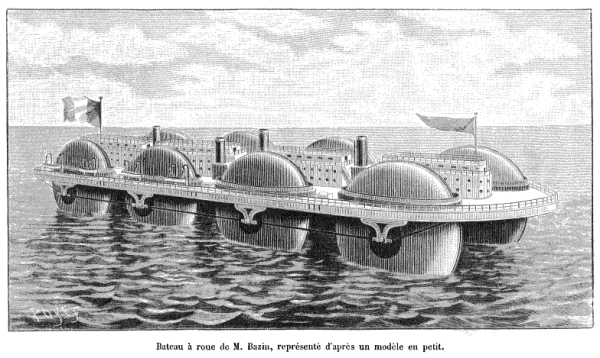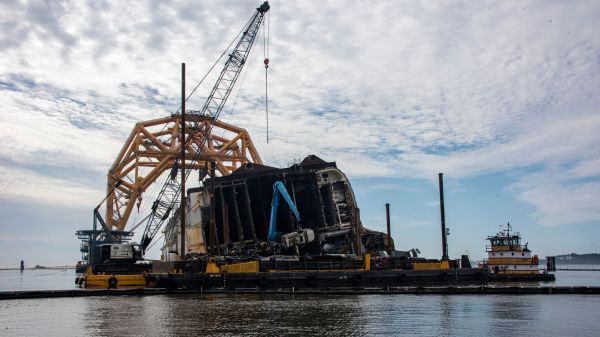“The brickings will continue until the printer sales improve!” This whole printer-bricking thing seems to be getting out of hand with the news this week that a firmware update caused certain HP printers to go into permanent paper-saver mode. The update was sent to LaserJet MFP M232-M237 models (opens printer menu; checks print queue name; “Phew!) on March 4, and was listed as covering a few “general improvements and bug fixes,” none of which seem very critical. Still, some users reported not being able to print at all after the update, with an error message suggesting printing was being blocked thanks to non-OEM toner. This sounds somewhat similar to the bricked Brother printers we reported on last week (third paragraph).
ship22 Articles
Man Overboard Systems Aim To Increase Survival Rates At Sea
When you hear the cry of “Man Overboard!” on a ship, it’s an emergency situation. The sea is unkind to those that fall from their vessel, and survival is never guaranteed—even in the most favorable conditions. Raging swell and the dark of night can only make rescue more impossible.
Over the centuries, naval tradition has included techniques to find and recover the person in the water as quickly and safely as possible. These days, though, technology is playing an ever-greater role in such circumstances. Modern man-overboard (MOB) systems are designed to give crews of modern vessels a fighting chance when rescuing those in peril.
Continue reading “Man Overboard Systems Aim To Increase Survival Rates At Sea”
The SS United States: The Most Important Ocean Liner We May Soon Lose Forever
Although it’s often said that the era of ocean liners came to an end by the 1950s with the rise of commercial aviation, reality isn’t quite that clear-cut. Coming out of the troubled 1940s arose a new kind of ocean liner, one using cutting-edge materials and propulsion, with hybrid civil and military use as the default, leading to a range of fascinating design decisions. This was the context in which the SS United States was born, with the beating heart of the US’ fastest battle ships, with light-weight aluminium structures and survivability built into every single aspect of its design.
Outpacing the super-fast Iowa-class battleships with whom it shares a lot of DNA due to its lack of heavy armor and triple 16″ turrets, it easily became the fastest ocean liner, setting speed records that took decades to be beaten by other ocean-going vessels, though no ocean liner ever truly did beat it on speed or comfort. Tricked out in the most tasteful non-flammable 1950s art and decorations imaginable, it would still be the fastest and most comfortable way to cross the Atlantic today. Unfortunately ocean liners are no longer considered a way to travel in this era of commercial aviation, leading to the SS United States and kin finding themselves either scrapped, or stuck in limbo.
In the case of the SS United States, so far it has managed to escape the cutting torch, but while in limbo many of its fittings were sold off at auction, and the conservation group which is in possession of the ship is desperately looking for a way to fund the restoration. Most recently, the owner of the pier where the ship is moored in Philadelphia got the ship’s eviction approved by a judge, leading to very tough choices to be made by September.
Continue reading “The SS United States: The Most Important Ocean Liner We May Soon Lose Forever”
The Roller Ship Was Not An Effective Way To Cross The High Seas
Boats come in all shapes and sizes. We have container ships, oil tankers, old-timey wooden sailing ships, catamarans, trimarans, and all sorts besides. Most are designed with features that give them a certain advantage or utility that justifies their construction for a given application.
The roller ship, on the other hand, has not justified its own repeat construction. Just one example was ever built, which proved unseaworthy and impractical. Let’s explore this nautical oddity and learn about why it didn’t make waves as its inventor may have hoped.
Continue reading “The Roller Ship Was Not An Effective Way To Cross The High Seas”
RORO Vessels: Driving Cars Across The Ocean
YouTube does a pretty good job of making itself a target for criticism, but one thing you can say about their algorithms: when they work, they really work. Case in point, the other day I found a suggestion in my feed for a very recent video about salvaging a shipwreck. I can’t begin to guess what combination of view history and metadata Google mined to come to the conclusion that I’d be interested in this video, but they hit the nail on the head.
But more importantly, their algorithmic assessment of my interests must have been a goldmine to them — or it could have been if I didn’t have a minefield of ad blockers protecting me — because I fell down a rabbit hole that led me to a bunch of interesting videos. As it turns out, the shipwreck in that first video was of a cargo ship that was carrying thousands of brand-new automobiles, which were all destroyed in the fire and subsequent capsizing of a “roll-on/roll-off” (RORO) vessel off the coast of Georgia (the state, not the country) in 2019.
Thus began my journey into RORO vessels, on which automobiles and other bulky cargo are transported around the world. And while my personal assessment of the interests of Hackaday readers probably is not as finely tuned as Google’s algos, I figured there’s a better than decent chance that people might enjoy tagging along too.
Continue reading “RORO Vessels: Driving Cars Across The Ocean”
The World’s First Autonomous Electric Cargo Ship Is Due To Set Sail
Maritime shipping is big business, with gigantic container ships responsible for moving the vast majority of the world’s goods from point A to points B, C and D. Of course, there’s a significant environmental impact from all this activity, something ill befitting the cleaner, cooler world we hope the future will be. Thus, alternatives to the fossil fuel burning ships of old must be found. To that end, Norwegian company Yara International has developed a zero-emission ship by the name of Yara Birkeland, which aims to show the way forward into a world of electric, autonomous sea transport.
Continue reading “The World’s First Autonomous Electric Cargo Ship Is Due To Set Sail”
A Big Ship Chop Shop On The Georgia Coast
Last week we saw a hapless container ship vaulted to fame, where people converged on its combination of mind-boggling size suffering an easily relatable problem of getting stuck. Now that it is moving again, armchair engineers who crave more big ship problem-solving should check out [David Tracy]’s writeup on the salvage operation of an overturned car carrier ship, the MV Golden Ray published by Jalopnik. If the ship’s name doesn’t ring a bell, the writeup opens with a quick recap.
Written for an audience of gearheads, [Tracy]’s writeup walks through some technical aspects of the salvage plan and initial results of execution. Citing from the official entity in charge, the St. Simons Sound Incident Response Unified Command, and augmented with information from elsewhere. Even though the MV Golden Ray is “only’ half the length and a third of the gross tonnage of our meme darling MV Ever Given, it is still a huge ship. Every salvage operation this big is unique, requiring knowledge far beyond our everyday intuition. At this scale, most Internet “Why don’t they just…” comments range from impractical to absurd.
Fortunately, people who actually know how to perform salvage work designed plans, submitted by multiple bidders, each making a different tradeoff in cost and speed among other factors. The chosen plan was to cut the ship into sections small enough to be carried by barge for further processing elsewhere. This required a huge floating crane, a chain pressed into cutter duty, custom fabricated lugs for lifting, and similarly custom fabricated cradles for the barges.
But we all know that no plan survives contact with reality. While this plan was seemingly chosen for speed, it hasn’t gone nearly as fast as advertised. Certainly the pandemic was a huge hinderance, but cutting has also been slowed by pieces built far stronger than spec. Delays also meant more sediment buildup inside the wreck, compounding headaches. Other bidders have started saying that if their plan had been chosen the job would be done by now, but who’s to say their plan wouldn’t have encountered their own problems?
In time St. Simons Sound will be cleared as the Suez Canal has been. Results of their respective investigations should help make shipping safer, but salvage skills will still be needed in the future. At least this operation isn’t as controversial as trying to retrieve the radio room of RMS Titanic.


















